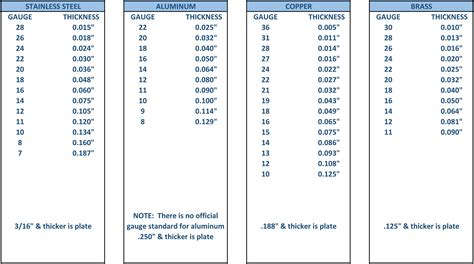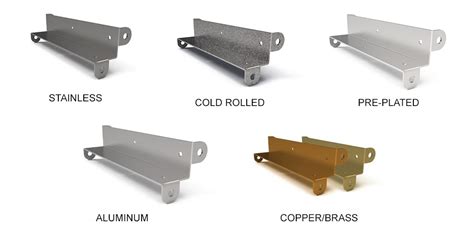common sheet metal Today’s most common sheet metal types in industry include stainless steel, aluminum, carbon steel, and copper. Understanding your project’s specific needs is the key to choosing the suitable sheet metal. Consider factors like strength, . I know everyone loves their US General boxes, but does anyone know what gauge steel they actually are? HF doesn't list it anywhere in their descriptions, only that they're heavy duty. .
0 · which thickness called sheet metal
1 · types of sheet metal material
2 · sheet metal material list pdf
3 · sheet metal material list
4 · sheet metal material grade
5 · sheet metal grades and properties
6 · 4x8 sheet metal price list
7 · 20 gauge sheet metal lowe's
Today keys are made out of nickel silver, brass, and steel. Some companies even recycle brass casings to press and create keys. Steel keys require a different, harder blade in order to cut on duplicating machines.
Let’s dive into the 8 most common sheet metals you’ll find in metal fabrication shops, exploring their unique advantages, disadvantages, and typical applications. Aluminum advantages: Lightweight: Great for applications where .
Many different types of metal can be processed into sheet form, including aluminum, brass, copper, steel, titanium, tin and stainless steel, to name some common ones. Sheet sizes also come in multiple thicknesses. Sheet metal has its roles to play in the household, semi-commercial, commercial and industrial sectors. And whoever working with these sheets, have to deal with mixed types of them. So, what are these types? How . Sheet metal is required across many industries, from automotive to aerospace, construction to electronics. The wide range of materials it offers, such as aluminum, steel, and copper, lends to its versatility, each providing .Today’s most common sheet metal types in industry include stainless steel, aluminum, carbon steel, and copper. Understanding your project’s specific needs is the key to choosing the suitable sheet metal. Consider factors like strength, .
Pretty much all the common engineering metals are also used in the form of sheets. Some of them are carbon steel, stainless steel, copper and aluminium. Choosing the right one for you comes down to the application and . In this guide, we'll look at the most common sheet metal materials used and go over the factors that need to be considered when choosing the right material. There are many .

which thickness called sheet metal
Learn about the six imperative materials used in sheet metal fabrication. Discover their properties, applications and importance in the manufacturing process. Let’s dive into the 8 most common sheet metals you’ll find in metal fabrication shops, exploring their unique advantages, disadvantages, and typical applications. Aluminum advantages: Lightweight: Great for applications where weight reduction is key, such as in automotive and aerospace industries. Most common materials found in precision sheet metal fabrication include: Austenitic stainless is a non-magnetic – any of the 300 series steel – that contains high levels of chromium and nickel and low levels of carbon. Known for their formability and resistance to corrosion, these are the most widely used grade of stainless steel.
Many different types of metal can be processed into sheet form, including aluminum, brass, copper, steel, titanium, tin and stainless steel, to name some common ones. Sheet sizes also come in multiple thicknesses. Sheet metal has its roles to play in the household, semi-commercial, commercial and industrial sectors. And whoever working with these sheets, have to deal with mixed types of them. So, what are these types? How do they differ from themselves? And what are the uses? Sheet metal is required across many industries, from automotive to aerospace, construction to electronics. The wide range of materials it offers, such as aluminum, steel, and copper, lends to its versatility, each providing unique .Today’s most common sheet metal types in industry include stainless steel, aluminum, carbon steel, and copper. Understanding your project’s specific needs is the key to choosing the suitable sheet metal. Consider factors like strength, durability, cost, .
Pretty much all the common engineering metals are also used in the form of sheets. Some of them are carbon steel, stainless steel, copper and aluminium. Choosing the right one for you comes down to the application and requirements of your product. Metal sheets have the same mechanical properties as the base metal.
In this guide, we'll look at the most common sheet metal materials used and go over the factors that need to be considered when choosing the right material. There are many types of sheet metal, and each type has its benefits and drawbacks that must be considered when selecting a material for a project.Here are some things to look for when considering four of the most common types of sheet metal in the industry. 1. Will your parts be cut on a laser, plasma or punched? 2. Will your parts be painted? 3. Will your finished parts be an indoor or outdoor part? Learn about the six imperative materials used in sheet metal fabrication. Discover their properties, applications and importance in the manufacturing process. Let’s dive into the 8 most common sheet metals you’ll find in metal fabrication shops, exploring their unique advantages, disadvantages, and typical applications. Aluminum advantages: Lightweight: Great for applications where weight reduction is key, such as in automotive and aerospace industries.
Most common materials found in precision sheet metal fabrication include: Austenitic stainless is a non-magnetic – any of the 300 series steel – that contains high levels of chromium and nickel and low levels of carbon. Known for their formability and resistance to corrosion, these are the most widely used grade of stainless steel. Many different types of metal can be processed into sheet form, including aluminum, brass, copper, steel, titanium, tin and stainless steel, to name some common ones. Sheet sizes also come in multiple thicknesses.
Sheet metal has its roles to play in the household, semi-commercial, commercial and industrial sectors. And whoever working with these sheets, have to deal with mixed types of them. So, what are these types? How do they differ from themselves? And what are the uses? Sheet metal is required across many industries, from automotive to aerospace, construction to electronics. The wide range of materials it offers, such as aluminum, steel, and copper, lends to its versatility, each providing unique .Today’s most common sheet metal types in industry include stainless steel, aluminum, carbon steel, and copper. Understanding your project’s specific needs is the key to choosing the suitable sheet metal. Consider factors like strength, durability, cost, . Pretty much all the common engineering metals are also used in the form of sheets. Some of them are carbon steel, stainless steel, copper and aluminium. Choosing the right one for you comes down to the application and requirements of your product. Metal sheets have the same mechanical properties as the base metal.
In this guide, we'll look at the most common sheet metal materials used and go over the factors that need to be considered when choosing the right material. There are many types of sheet metal, and each type has its benefits and drawbacks that must be considered when selecting a material for a project.

types of sheet metal material
I know everyone loves their US General boxes, but does anyone know what gauge steel they actually are? HF doesn't list it anywhere in their descriptions, only that they're heavy duty. Every other toolbox manufacturer lists the gauge of .
common sheet metal|sheet metal material grade